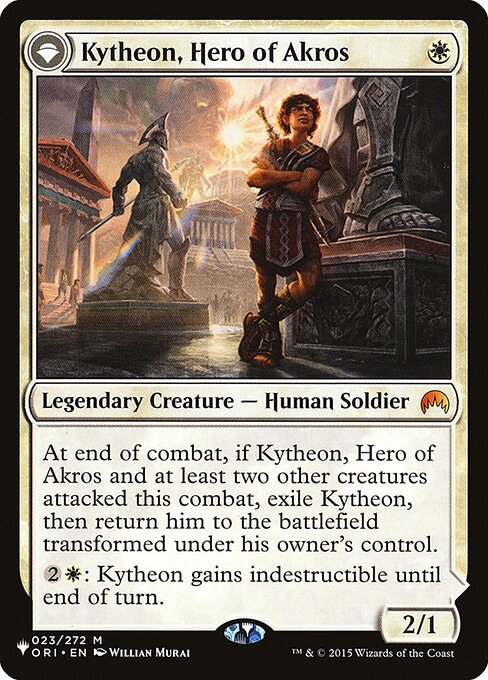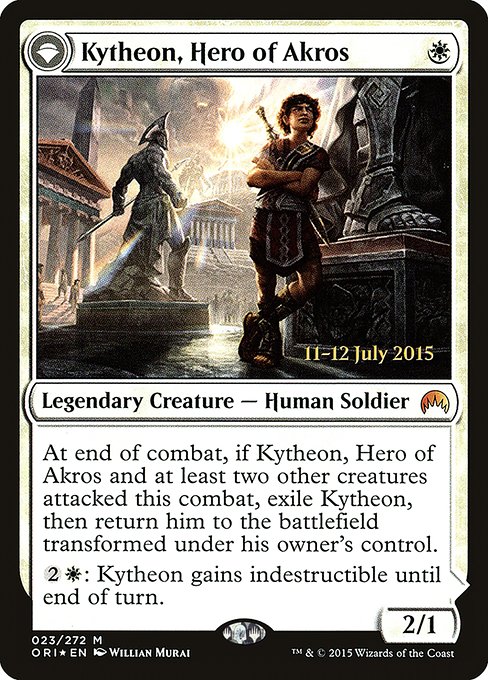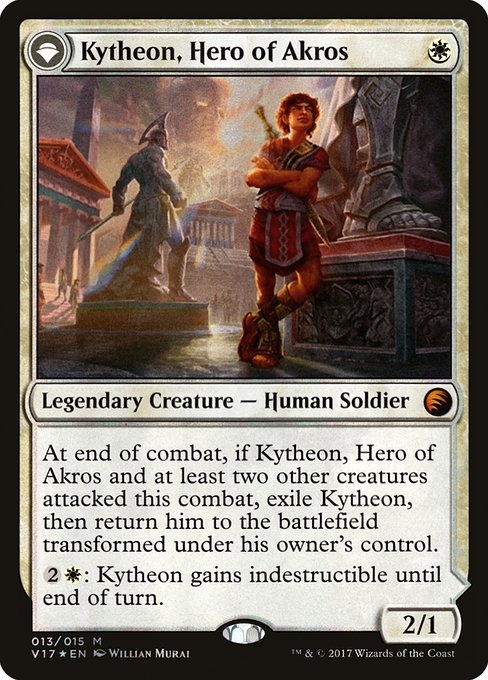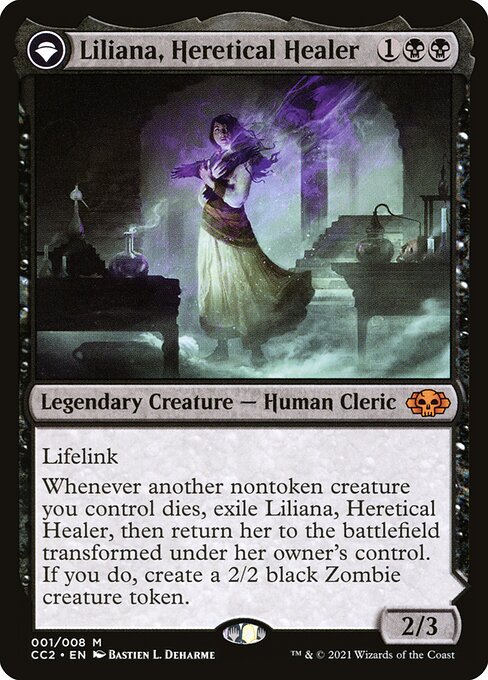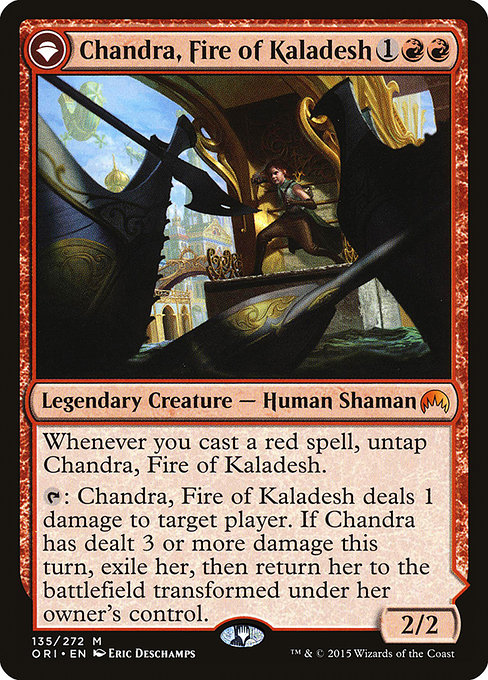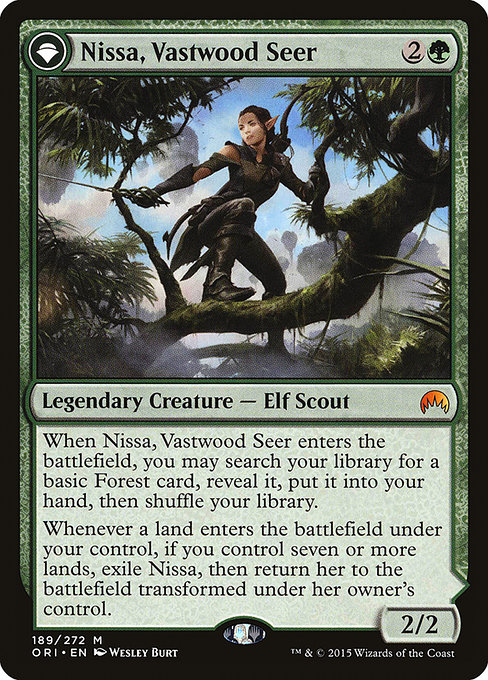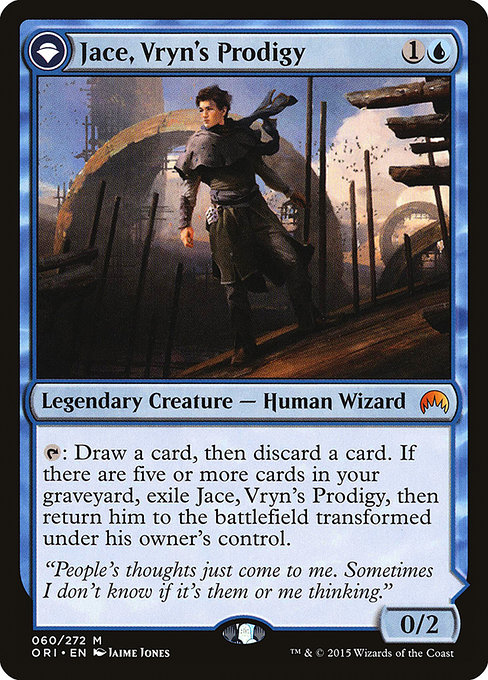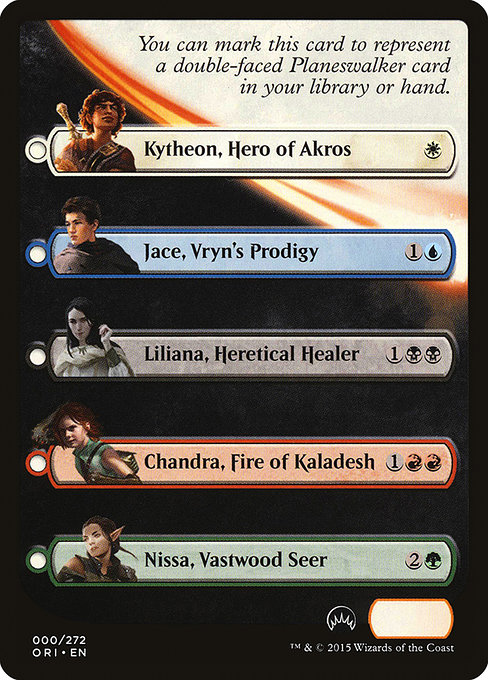Kytheon, Eroe di Akros // Gideon, Forgiato dalla Battaglia
//
Creatura Leggendaria — Soldato Umano // Planeswalker — Gideon
Alla fine del combattimento, se Kytheon, Eroe di Akros e almeno altre due creature hanno attaccato in questo combattimento, esilia Kytheon, poi rimettilo sul campo di battaglia trasformato sotto il controllo del suo proprietario.: Kytheon ha indistruttibile fino alla fine del turno. // +2: Fino a una creatura bersaglio controllata da un avversario attacca Gideon, Forgiato dalla Battaglia durante il prossimo turno del suo controllore, se può farlo.+1: Fino al tuo prossimo turno, una creatura bersaglio ha indistruttibile. STAPpa quella creatura.0: Fino alla fine del turno, Gideon, Forgiato dalla Battaglia diventa una creatura Soldato Umano 4/4 con indistruttibile che è ancora un planeswalker. Previeni tutto il danno che gli verrebbe inflitto in questo turno.
2/1
standard
future
historic
gladiator
pioneer
explorer
modern
legacy
pauper
vintage
penny
commander
brawl
alchemy
paupercommander
duel
oldschool
premodern
Rulings
If you activate Gideon’s third ability and then damage is dealt to him that can’t be prevented, that damage has all applicable results: specifically, the damage is marked on Gideon (since he’s a creature) and that damage causes that many loyalty counters to be removed from him (since he’s a planeswalker). If Gideon has no loyalty counters on him, he’s put into his owner’s graveyard as a state-based action. (As long as he still has indestructible, the marked damage won’t cause him to be destroyed.)
The back face of a double-faced card (in the case of Magic Origins, the planeswalker face) can’t be cast.
The converted mana cost of a double-faced card not on the battlefield is the converted mana cost of its front face.
If Gideon can’t be attacked, perhaps because he has left the battlefield before the creature’s controller’s next combat, the creature targeted by Gideon’s first ability can attack you or another planeswalker you control, or its controller can choose to have it not attack at all.
If a double-faced card is manifested, it will be put onto the battlefield face down (this is also true if it’s put onto the battlefield face down some other way). Note that “face down” is not synonymous with “with its back face up.” A manifested double-faced card is a 2/2 creature with no name, mana cost, creature types, or abilities. While face down, it can’t transform. If the front face of a manifested double-faced card is a creature card, you can turn it face up by paying its mana cost. If you do, its front face will be up. A double-faced card on the battlefield can’t be turned face down.
You can activate one of the planeswalker’s loyalty abilities the turn it enters the battlefield. However, you may do so only during one of your main phases when the stack is empty. For example, if the planeswalker enters the battlefield during combat, there will be an opportunity for your opponent to remove it before you can activate one of its abilities.
Gideon’s first ability causes a creature to attack him if able. If, during its controller’s declare attackers step, that creature is tapped, is affected by a spell or ability that says it can’t attack, or hasn’t been under its controller’s control continuously since that player’s turn began, then that creature doesn’t attack. If there’s a cost associated with having that creature attack, its controller isn’t forced to pay that cost. If they don’t, the creature doesn’t have to attack.
If Gideon becomes a creature due to his third ability, that doesn’t count as having a creature enter the battlefield. Gideon was already on the battlefield; he only changed his types. Abilities that trigger whenever a creature enters the battlefield won’t trigger.
A double-faced card enters the battlefield with its front face up by default, unless a spell or ability instructs you to put it onto the battlefield transformed, in which case it enters with its back face up.
If the creature targeted by Gideon’s first ability changes controllers before it has the chance to attack Gideon, the ability will apply to it during its new controller’s next turn.
In some rare cases, a spell or ability may cause one of these five cards to transform while it’s a creature (front face up) on the battlefield. If this happens, the resulting planeswalker won’t have any loyalty counters on it and will subsequently be put into its owner’s graveyard.
A Magic Origins planeswalker that enters the battlefield because of the ability of its front face will enter with loyalty counters as normal.
Say you activate Gideon’s third ability, then an opponent gains control of him before combat. You may have any of your creatures attack Gideon (since he’s still a planeswalker). Then Gideon may block (since he’s a creature). He may block any eligible attacking creature, including one that’s attacking him. During combat, he behaves as an attacked planeswalker and/or a blocking creature, as appropriate. For example, he deals combat damage to any creatures he’s blocking, but he doesn’t deal combat damage to any unblocked creatures that are attacking him.
Each face of a double-faced card has its own set of characteristics: name, types, subtypes, power and toughness, loyalty, abilities, and so on. While a double-faced card is on the battlefield, consider only the characteristics of the face that’s currently up. The other set of characteristics is ignored. While a double-faced card isn’t on the battlefield, consider only the characteristics of its front face.
Kytheon’s first ability will count creatures that attacked but are no longer on the battlefield (perhaps because they didn’t survive combat damage being dealt). It will not count any creatures that were put onto the battlefield attacking, as those creatures were never declared as attackers.
Gideon’s third ability causes him to become a creature with the creature types Human Soldier. He remains a planeswalker with the planeswalker type Gideon. (He also retains any other card types or subtypes he may have had.) Each subtype is correlated to the proper card type: Gideon is just a planeswalker type (not a creature type), and Human and Soldier are just creature types (not planeswalker types).
The back face of a double-faced card doesn’t have a mana cost. A double-faced permanent with its back face up has a converted mana cost equal to the converted mana cost of its front face. Each back face has a color indicator that defines its color.
For more information on double-faced cards, see the Shadows over Innistrad mechanics article (http://magic.wizards.com/en/articles/archive/feature/shadows-over-innistrad-mechanics).
You can control two of this permanent, one front-face up and the other back-face up, at the same time.
The back face of a double-faced card (in the case of Magic Origins, the planeswalker face) can’t be cast.
The converted mana cost of a double-faced card not on the battlefield is the converted mana cost of its front face.
If Gideon can’t be attacked, perhaps because he has left the battlefield before the creature’s controller’s next combat, the creature targeted by Gideon’s first ability can attack you or another planeswalker you control, or its controller can choose to have it not attack at all.
If a double-faced card is manifested, it will be put onto the battlefield face down (this is also true if it’s put onto the battlefield face down some other way). Note that “face down” is not synonymous with “with its back face up.” A manifested double-faced card is a 2/2 creature with no name, mana cost, creature types, or abilities. While face down, it can’t transform. If the front face of a manifested double-faced card is a creature card, you can turn it face up by paying its mana cost. If you do, its front face will be up. A double-faced card on the battlefield can’t be turned face down.
You can activate one of the planeswalker’s loyalty abilities the turn it enters the battlefield. However, you may do so only during one of your main phases when the stack is empty. For example, if the planeswalker enters the battlefield during combat, there will be an opportunity for your opponent to remove it before you can activate one of its abilities.
Gideon’s first ability causes a creature to attack him if able. If, during its controller’s declare attackers step, that creature is tapped, is affected by a spell or ability that says it can’t attack, or hasn’t been under its controller’s control continuously since that player’s turn began, then that creature doesn’t attack. If there’s a cost associated with having that creature attack, its controller isn’t forced to pay that cost. If they don’t, the creature doesn’t have to attack.
If Gideon becomes a creature due to his third ability, that doesn’t count as having a creature enter the battlefield. Gideon was already on the battlefield; he only changed his types. Abilities that trigger whenever a creature enters the battlefield won’t trigger.
A double-faced card enters the battlefield with its front face up by default, unless a spell or ability instructs you to put it onto the battlefield transformed, in which case it enters with its back face up.
If the creature targeted by Gideon’s first ability changes controllers before it has the chance to attack Gideon, the ability will apply to it during its new controller’s next turn.
In some rare cases, a spell or ability may cause one of these five cards to transform while it’s a creature (front face up) on the battlefield. If this happens, the resulting planeswalker won’t have any loyalty counters on it and will subsequently be put into its owner’s graveyard.
A Magic Origins planeswalker that enters the battlefield because of the ability of its front face will enter with loyalty counters as normal.
Say you activate Gideon’s third ability, then an opponent gains control of him before combat. You may have any of your creatures attack Gideon (since he’s still a planeswalker). Then Gideon may block (since he’s a creature). He may block any eligible attacking creature, including one that’s attacking him. During combat, he behaves as an attacked planeswalker and/or a blocking creature, as appropriate. For example, he deals combat damage to any creatures he’s blocking, but he doesn’t deal combat damage to any unblocked creatures that are attacking him.
Each face of a double-faced card has its own set of characteristics: name, types, subtypes, power and toughness, loyalty, abilities, and so on. While a double-faced card is on the battlefield, consider only the characteristics of the face that’s currently up. The other set of characteristics is ignored. While a double-faced card isn’t on the battlefield, consider only the characteristics of its front face.
Kytheon’s first ability will count creatures that attacked but are no longer on the battlefield (perhaps because they didn’t survive combat damage being dealt). It will not count any creatures that were put onto the battlefield attacking, as those creatures were never declared as attackers.
Gideon’s third ability causes him to become a creature with the creature types Human Soldier. He remains a planeswalker with the planeswalker type Gideon. (He also retains any other card types or subtypes he may have had.) Each subtype is correlated to the proper card type: Gideon is just a planeswalker type (not a creature type), and Human and Soldier are just creature types (not planeswalker types).
The back face of a double-faced card doesn’t have a mana cost. A double-faced permanent with its back face up has a converted mana cost equal to the converted mana cost of its front face. Each back face has a color indicator that defines its color.
For more information on double-faced cards, see the Shadows over Innistrad mechanics article (http://magic.wizards.com/en/articles/archive/feature/shadows-over-innistrad-mechanics).
You can control two of this permanent, one front-face up and the other back-face up, at the same time.
Rulings
If you activate Gideon’s third ability and then damage is dealt to him that can’t be prevented, that damage has all applicable results: specifically, the damage is marked on Gideon (since he’s a creature) and that damage causes that many loyalty counters to be removed from him (since he’s a planeswalker). If Gideon has no loyalty counters on him, he’s put into his owner’s graveyard as a state-based action. (As long as he still has indestructible, the marked damage won’t cause him to be destroyed.)
The back face of a double-faced card (in the case of Magic Origins, the planeswalker face) can’t be cast.
The converted mana cost of a double-faced card not on the battlefield is the converted mana cost of its front face.
If Gideon can’t be attacked, perhaps because he has left the battlefield before the creature’s controller’s next combat, the creature targeted by Gideon’s first ability can attack you or another planeswalker you control, or its controller can choose to have it not attack at all.
If a double-faced card is manifested, it will be put onto the battlefield face down (this is also true if it’s put onto the battlefield face down some other way). Note that “face down” is not synonymous with “with its back face up.” A manifested double-faced card is a 2/2 creature with no name, mana cost, creature types, or abilities. While face down, it can’t transform. If the front face of a manifested double-faced card is a creature card, you can turn it face up by paying its mana cost. If you do, its front face will be up. A double-faced card on the battlefield can’t be turned face down.
You can activate one of the planeswalker’s loyalty abilities the turn it enters the battlefield. However, you may do so only during one of your main phases when the stack is empty. For example, if the planeswalker enters the battlefield during combat, there will be an opportunity for your opponent to remove it before you can activate one of its abilities.
Gideon’s first ability causes a creature to attack him if able. If, during its controller’s declare attackers step, that creature is tapped, is affected by a spell or ability that says it can’t attack, or hasn’t been under its controller’s control continuously since that player’s turn began, then that creature doesn’t attack. If there’s a cost associated with having that creature attack, its controller isn’t forced to pay that cost. If they don’t, the creature doesn’t have to attack.
If Gideon becomes a creature due to his third ability, that doesn’t count as having a creature enter the battlefield. Gideon was already on the battlefield; he only changed his types. Abilities that trigger whenever a creature enters the battlefield won’t trigger.
A double-faced card enters the battlefield with its front face up by default, unless a spell or ability instructs you to put it onto the battlefield transformed, in which case it enters with its back face up.
If the creature targeted by Gideon’s first ability changes controllers before it has the chance to attack Gideon, the ability will apply to it during its new controller’s next turn.
In some rare cases, a spell or ability may cause one of these five cards to transform while it’s a creature (front face up) on the battlefield. If this happens, the resulting planeswalker won’t have any loyalty counters on it and will subsequently be put into its owner’s graveyard.
A Magic Origins planeswalker that enters the battlefield because of the ability of its front face will enter with loyalty counters as normal.
Say you activate Gideon’s third ability, then an opponent gains control of him before combat. You may have any of your creatures attack Gideon (since he’s still a planeswalker). Then Gideon may block (since he’s a creature). He may block any eligible attacking creature, including one that’s attacking him. During combat, he behaves as an attacked planeswalker and/or a blocking creature, as appropriate. For example, he deals combat damage to any creatures he’s blocking, but he doesn’t deal combat damage to any unblocked creatures that are attacking him.
Each face of a double-faced card has its own set of characteristics: name, types, subtypes, power and toughness, loyalty, abilities, and so on. While a double-faced card is on the battlefield, consider only the characteristics of the face that’s currently up. The other set of characteristics is ignored. While a double-faced card isn’t on the battlefield, consider only the characteristics of its front face.
Kytheon’s first ability will count creatures that attacked but are no longer on the battlefield (perhaps because they didn’t survive combat damage being dealt). It will not count any creatures that were put onto the battlefield attacking, as those creatures were never declared as attackers.
Gideon’s third ability causes him to become a creature with the creature types Human Soldier. He remains a planeswalker with the planeswalker type Gideon. (He also retains any other card types or subtypes he may have had.) Each subtype is correlated to the proper card type: Gideon is just a planeswalker type (not a creature type), and Human and Soldier are just creature types (not planeswalker types).
The back face of a double-faced card doesn’t have a mana cost. A double-faced permanent with its back face up has a converted mana cost equal to the converted mana cost of its front face. Each back face has a color indicator that defines its color.
For more information on double-faced cards, see the Shadows over Innistrad mechanics article (http://magic.wizards.com/en/articles/archive/feature/shadows-over-innistrad-mechanics).
You can control two of this permanent, one front-face up and the other back-face up, at the same time.
The back face of a double-faced card (in the case of Magic Origins, the planeswalker face) can’t be cast.
The converted mana cost of a double-faced card not on the battlefield is the converted mana cost of its front face.
If Gideon can’t be attacked, perhaps because he has left the battlefield before the creature’s controller’s next combat, the creature targeted by Gideon’s first ability can attack you or another planeswalker you control, or its controller can choose to have it not attack at all.
If a double-faced card is manifested, it will be put onto the battlefield face down (this is also true if it’s put onto the battlefield face down some other way). Note that “face down” is not synonymous with “with its back face up.” A manifested double-faced card is a 2/2 creature with no name, mana cost, creature types, or abilities. While face down, it can’t transform. If the front face of a manifested double-faced card is a creature card, you can turn it face up by paying its mana cost. If you do, its front face will be up. A double-faced card on the battlefield can’t be turned face down.
You can activate one of the planeswalker’s loyalty abilities the turn it enters the battlefield. However, you may do so only during one of your main phases when the stack is empty. For example, if the planeswalker enters the battlefield during combat, there will be an opportunity for your opponent to remove it before you can activate one of its abilities.
Gideon’s first ability causes a creature to attack him if able. If, during its controller’s declare attackers step, that creature is tapped, is affected by a spell or ability that says it can’t attack, or hasn’t been under its controller’s control continuously since that player’s turn began, then that creature doesn’t attack. If there’s a cost associated with having that creature attack, its controller isn’t forced to pay that cost. If they don’t, the creature doesn’t have to attack.
If Gideon becomes a creature due to his third ability, that doesn’t count as having a creature enter the battlefield. Gideon was already on the battlefield; he only changed his types. Abilities that trigger whenever a creature enters the battlefield won’t trigger.
A double-faced card enters the battlefield with its front face up by default, unless a spell or ability instructs you to put it onto the battlefield transformed, in which case it enters with its back face up.
If the creature targeted by Gideon’s first ability changes controllers before it has the chance to attack Gideon, the ability will apply to it during its new controller’s next turn.
In some rare cases, a spell or ability may cause one of these five cards to transform while it’s a creature (front face up) on the battlefield. If this happens, the resulting planeswalker won’t have any loyalty counters on it and will subsequently be put into its owner’s graveyard.
A Magic Origins planeswalker that enters the battlefield because of the ability of its front face will enter with loyalty counters as normal.
Say you activate Gideon’s third ability, then an opponent gains control of him before combat. You may have any of your creatures attack Gideon (since he’s still a planeswalker). Then Gideon may block (since he’s a creature). He may block any eligible attacking creature, including one that’s attacking him. During combat, he behaves as an attacked planeswalker and/or a blocking creature, as appropriate. For example, he deals combat damage to any creatures he’s blocking, but he doesn’t deal combat damage to any unblocked creatures that are attacking him.
Each face of a double-faced card has its own set of characteristics: name, types, subtypes, power and toughness, loyalty, abilities, and so on. While a double-faced card is on the battlefield, consider only the characteristics of the face that’s currently up. The other set of characteristics is ignored. While a double-faced card isn’t on the battlefield, consider only the characteristics of its front face.
Kytheon’s first ability will count creatures that attacked but are no longer on the battlefield (perhaps because they didn’t survive combat damage being dealt). It will not count any creatures that were put onto the battlefield attacking, as those creatures were never declared as attackers.
Gideon’s third ability causes him to become a creature with the creature types Human Soldier. He remains a planeswalker with the planeswalker type Gideon. (He also retains any other card types or subtypes he may have had.) Each subtype is correlated to the proper card type: Gideon is just a planeswalker type (not a creature type), and Human and Soldier are just creature types (not planeswalker types).
The back face of a double-faced card doesn’t have a mana cost. A double-faced permanent with its back face up has a converted mana cost equal to the converted mana cost of its front face. Each back face has a color indicator that defines its color.
For more information on double-faced cards, see the Shadows over Innistrad mechanics article (http://magic.wizards.com/en/articles/archive/feature/shadows-over-innistrad-mechanics).
You can control two of this permanent, one front-face up and the other back-face up, at the same time.
Votre collection ? vos decks ?
Envie de gérer votre collection et/ou créer des decks ?
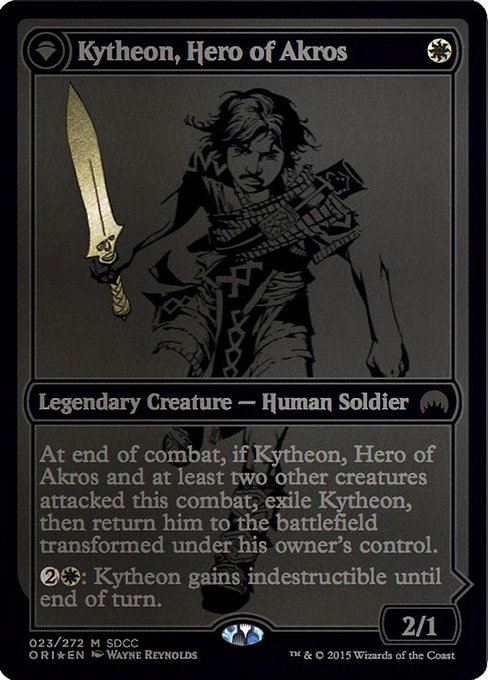

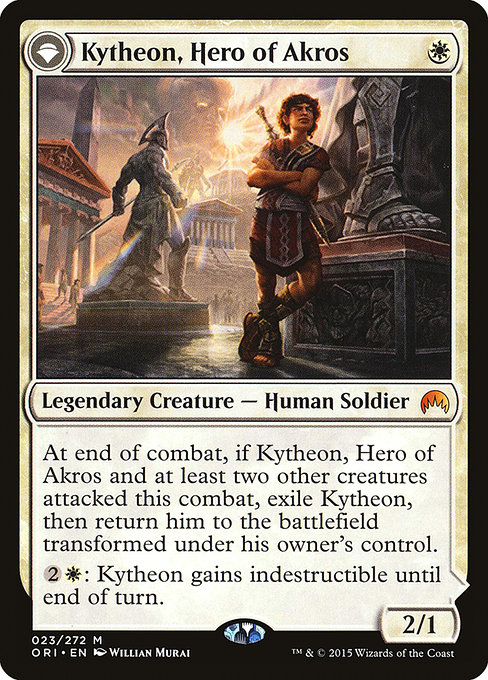
 0
0
 4.40€
4.40€
